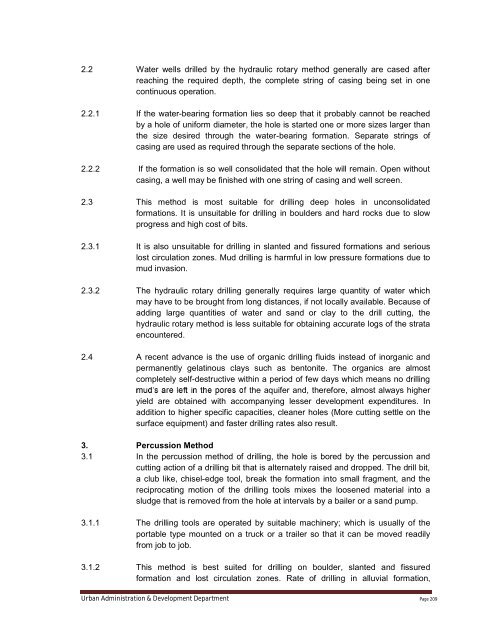Specifications Part 1 - Water Supply, Sewerage and Tube Well Works
Specifications Part 1 - Water Supply, Sewerage and Tube Well Works
Specifications Part 1 - Water Supply, Sewerage and Tube Well Works
You also want an ePaper? Increase the reach of your titles
YUMPU automatically turns print PDFs into web optimized ePapers that Google loves.
2.2 <strong>Water</strong> wells drilled by the hydraulic rotary method generally are cased afterreaching the required depth, the complete string of casing being set in onecontinuous operation.2.2.1 If the water-bearing formation lies so deep that it probably cannot be reachedby a hole of uniform diameter, the hole is started one or more sizes larger thanthe size desired through the water-bearing formation. Separate strings ofcasing are used as required through the separate sections of the hole.2.2.2 If the formation is so well consolidated that the hole will remain. Open withoutcasing, a well may be finished with one string of casing <strong>and</strong> well screen.2.3 This method is most suitable for drilling deep holes in unconsolidatedformations. It is unsuitable for drilling in boulders <strong>and</strong> hard rocks due to slowprogress <strong>and</strong> high cost of bits.2.3.1 It is also unsuitable for drilling in slanted <strong>and</strong> fissured formations <strong>and</strong> seriouslost circulation zones. Mud drilling is harmful in low pressure formations due tomud invasion.2.3.2 The hydraulic rotary drilling generally requires large quantity of water whichmay have to be brought from long distances, if not locally available. Because ofadding large quantities of water <strong>and</strong> s<strong>and</strong> or clay to the drill cutting, thehydraulic rotary method is less suitable for obtaining accurate logs of the strataencountered.2.4 A recent advance is the use of organic drilling fluids instead of inorganic <strong>and</strong>permanently gelatinous clays such as bentonite. The organics are almostcompletely self-destructive within a period of few days which means no drillingf the aquifer <strong>and</strong>, therefore, almost always higheryield are obtained with accompanying lesser development expenditures. Inaddition to higher specific capacities, cleaner holes (More cutting settle on thesurface equipment) <strong>and</strong> faster drilling rates also result.3. Percussion Method3.1 In the percussion method of drilling, the hole is bored by the percussion <strong>and</strong>cutting action of a drilling bit that is alternately raised <strong>and</strong> dropped. The drill bit,a club like, chisel-edge tool, break the formation into small fragment, <strong>and</strong> thereciprocating motion of the drilling tools mixes the loosened material into asludge that is removed from the hole at intervals by a bailer or a s<strong>and</strong> pump.3.1.1 The drilling tools are operated by suitable machinery; which is usually of theportable type mounted on a truck or a trailer so that it can be moved readilyfrom job to job.3.1.2 This method is best suited for drilling on boulder, slanted <strong>and</strong> fissuredformation <strong>and</strong> lost circulation zones. Rate of drilling in alluvial formation,Urban Administration & Development Department Page 209
















